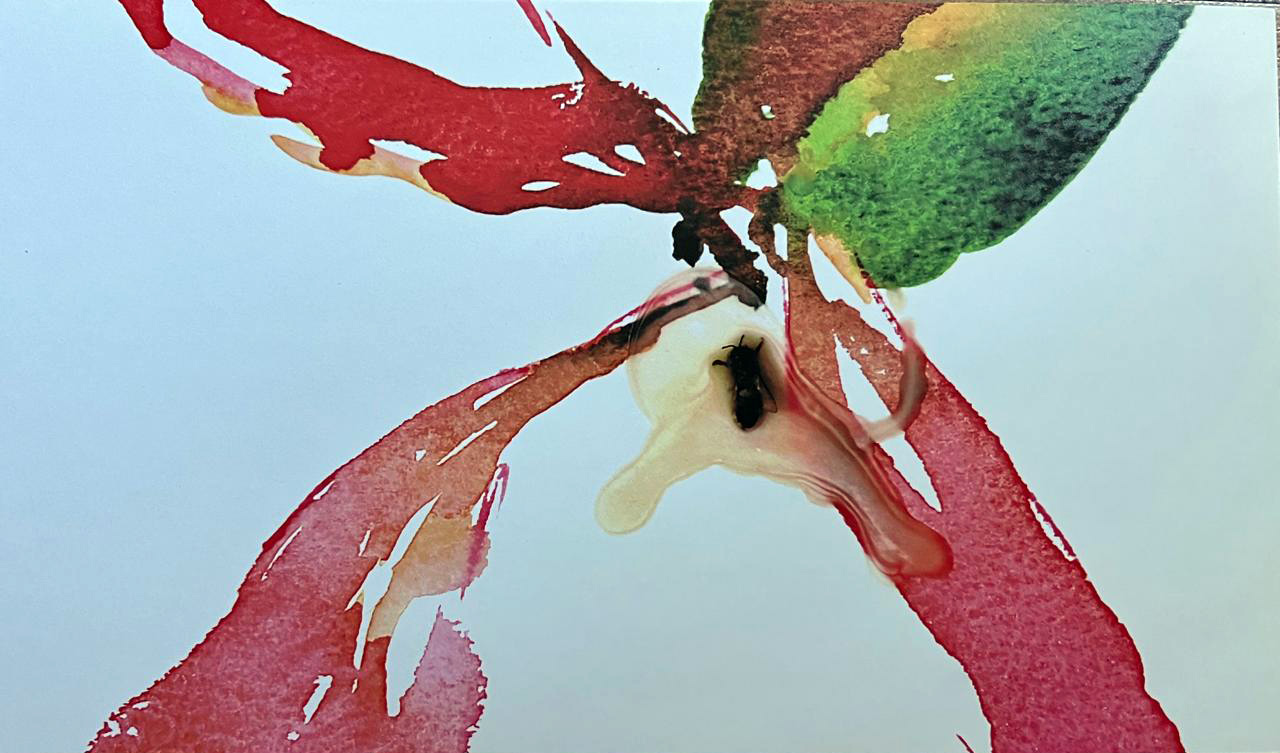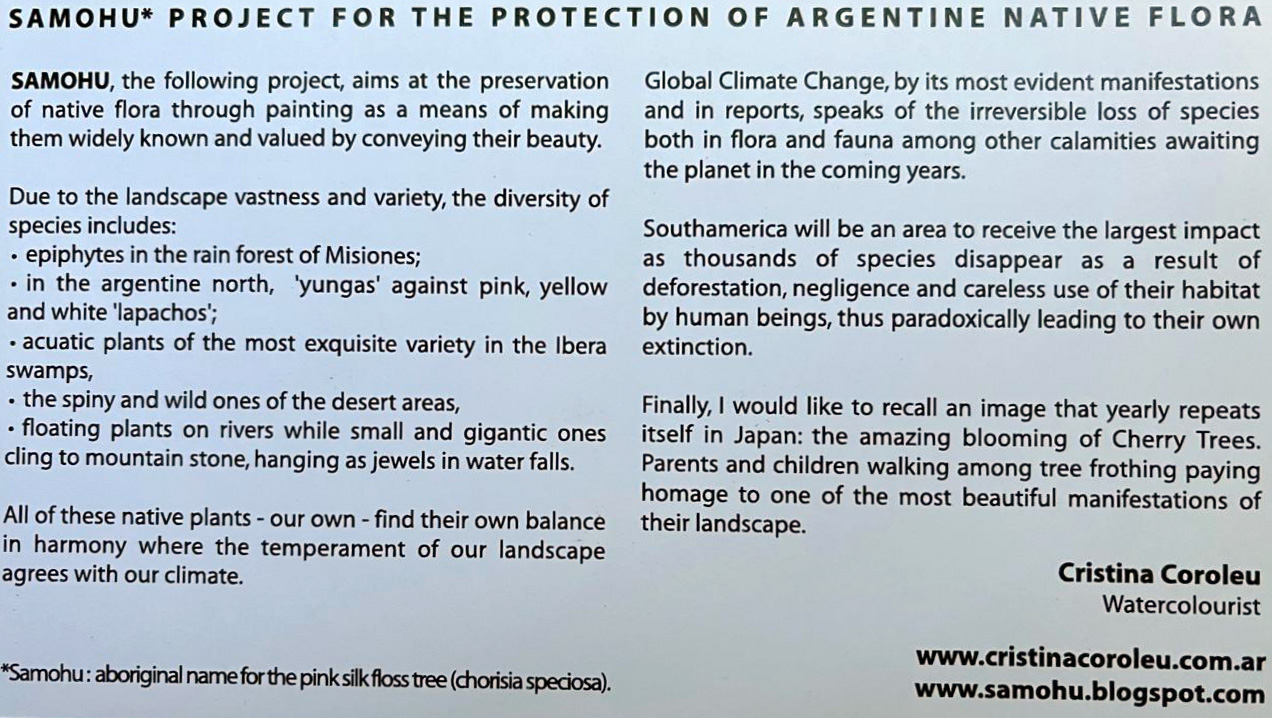

Cristina Coroleu projects are now essentially related to the Native Flowering, the ones who were selected for the first time by the French landscape architect Charles Thays, the founder of the Botanical Gardens of Buenos Aires and the republic landscape.
Seminars and courses had been given all around the country: Salta, Entre Rios, Tucuman y Rio Grande. A whole new bunch of students had been incorporated, enthusiastic with
the idea of representing the most important native flowers of each region into a painting project.
Cristina Coroleu initiates her work with the five most known species of trees (Lapacho, Ceibo, Jacaranda, Tipa, Palo borracho) and tries to extend this point of view to the different regions of the country.
This is the way she founds to make them visible, by achieving this, she aims to protect them from continues predation and the negligence that puts them in danger of extinction.
This loss not only constitutes the disappearance of something really beautiful for our eyes, but it is also fundamental for the life living of this planet.
This is the spirit that flows within the workshops, and future projects.
Perseverance and passion at the service of the outdoor flowers.
Native Flowering Project in Argentina: Samohu ©
The following project called "samohú" was born from my growing interest in the native flora that’s been developing many years from now.
During the beginning “Flowering Buenos Aires” was the first step in the observation and study of the five arboreal species that surrounds us in the urban landscape. These trees forms all together a seasonal colour palette that each and every year has been reciting in public squares and parks. This was the first selection of the well- known landscape architect Charles Thays (1849 - 1934) and that afterwards was the one continued by his disciples in a scientific and poetic way.
Species from the North, northwest and shared regions from the nearby countries as Brasil, Uruguay and Paraguay were selected in order to adorn the public squares and spaces. Achieving to conform this city into an explicable, open, green and monumental beauty as it is the city of Buenos Aires. This work was also done in other important cities all around Argentina. Thanks to Thays and his disciples, Argentina provides a distinguish architecture urban landscape.
Each one of this flowers had been and still are the object of my work. The idea of deepen them give and brings me hundreds of forms and colours, that constitutes
the native flora of the different regions of this territory. Todas ellas nativas, propias, nuestras donde el temperamento de nuestro paisaje acorde con su clima y en equilibrio.
The diversity of species, taking into account the variety of the landscape, includes from epiphytes in the moist jungles in the region of Misiones, to the
yungas in the Argentine north together with the pink, yellow and white Lapachos; he aquatic ones in the most exquisite variance in Los Esteros del Ibera, and de
rugged and thorny in the deserted zones. We can also find the floating ones over the rivers, small and enormous ones graved to the rocks over the mountains,
hanging from them like jewels in the cascades. All of them are native, we own them, and we are holders. The atmosphere and charisma of our scenery is
connected to his climate and balance.
Watching where they belong, is a way of getting to know them deeply. It makes me feel the need and the joy of publicise them. I need every one to get in touch with them. I commit myself into this work together with my workshops in this crusade with flowers.
We started workshops in Salta and Entre Rios two years ago. We soon be travelling to the south. In every region we established “mother groups” of the flora, these groups involved a great variety and number of species and of painters doomed into the work of recognize and revalue them.
The Global Warming brings within concrete changings as Stern says -English economist who presented a formal request to his government in the year 2006-.
He talked about the irreparable lost flora and fauna, and others calamities that are expected to be suffer in this planet over becoming years.
South America will be one of the most affected zones, millions of species will disappear as a consequence of the deforestation, negligence and no care from
the human being all over the years; generating, paradoxically, their own extinction.
Every day, a different zone of the earth reveals the growing disparity: Ice, air, water, animals and flowers. The whole ecosystem in an interdependent way,
even the most miniscule of the forms it’s strongly been affected.
It’s really serious the time all the Nations of the Earth are spending in order to begin any action to preserve our world from the damage human had itself started. Flowers growing in the most inhospitable settings; showing in the most natural and beautiful way their vegetal splendour, are my object, my passion and my labour.
Under the title “Native flowering paintings, a way to protect them” I found the most appropriate way for them and for me to name the deal I choose to dispose.
My idea is to create groups of painters, and approach the native flora theme with the oriental technique throughout seminars where I can develop my ideals, taking s a beginning argument the first five species, who will be joining the ones corresponding to every region.
Meetings will been given by specialized engineers which will open and deepen the scientific knowledge.
“Mother groups” will be form.
This groups will connect within each other through exhibitions, as we already did in December 2006 in the Botanic Garden of Buenos Aires with groups from Salta and the local province. To continue with this idea, exhibitions will be held in Salta in “Abril Cultural”, the same thing will be happen in Entre Rios, where I did my
first seminar in September of 2005.
A growing interest for this project is right now in Ushuaia.
Only in two years flowering groups in regions far away were formed.
I´m now asking for the support from people, organizations and institutions not only to concrete and individual project but, an issue that could involves and
distinguish us as a region. And also includes the preservation of our natural flora from the changing climate.
To conclude, I will like to mention an image that has been repeated in Japan over the past’s years, with the astonishing flowering of the cherry-tree.
Father and son walks through the foam of these trees as an emotive tribute to one of the most stunning manifestations of landscape.
